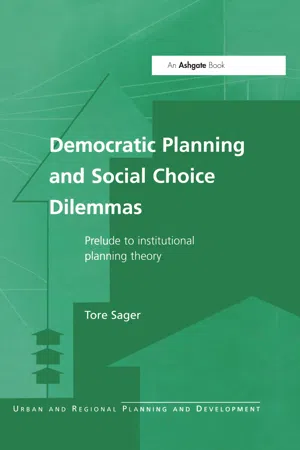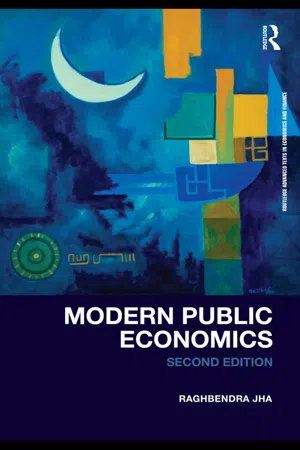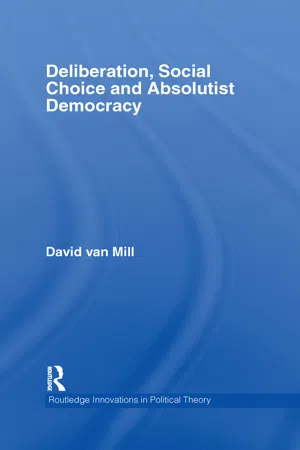Economics
Arrow's Impossibility Theorem
Arrow's Impossibility Theorem, formulated by economist Kenneth Arrow, states that it is impossible to create a voting system that satisfies a set of desirable criteria. These criteria include unrestricted domain, non-dictatorship, Pareto efficiency, and independence of irrelevant alternatives. The theorem has significant implications for understanding the limitations of democratic decision-making processes.
Written by Perlego with AI-assistance
Related key terms
6 Key excerpts on "Arrow's Impossibility Theorem"
- eBook - ePub
Democratic Planning and Social Choice Dilemmas
Prelude to Institutional Planning Theory
- Tore Sager(Author)
- 2020(Publication Date)
- Routledge(Publisher)
They hold that unrestricted scope and IIA are conditions to the effect that the institution should be a ‘real-world’ decision rule. (Most election procedures satisfy these conditions.) Furthermore, they regard the Pareto principle and non-dictatorship as conditions to the effect that the decision rule should be ‘reasonable’. Applied to voting, they can then reinterpret Arrow’s theorem to say that: ‘Every reasonable real-world voting rule is manipulable through strategic candidacies and similar maneuvers’ (ibid. 184). In the context of dialogical decision-making, this means that the outcome can be manipulated by altering the set of planning alternatives under consideration. This links Arrow’s theorem to the problem of manipulation discussed in Part III. It will now be investigated whether it is really necessary to limit the argumentative impossibility theorem to debates involving intangibles. Generalization of the Impossibility Result The aim of this section is to show that the scope of the impossibility theorem of dialogical decision-making is much wider than one is led to believe from the direct analogy with Arrow’s reasoning. It is argued that the theorem is valid in nearly all cases of making recommendations from a societal point of view in, e.g., land-use and transport planning. Arrow (1963) took individual utility to be ordinal and non-comparable. The last assumption implies that utility levels or changes in utility cannot be compared across individuals. It has been known for some years that the possibility of aggregating the individual preference relations is critically dependent on their measurability and comparability. Research in social choice theory after the establishment of Arrow’s theorem has explored the exact nature of this dependence (Roberts 1980, Blackorby et al. 1984, Kelsey 1987). There is little room for sensible social choice when interpersonal comparison of utility is not allowed - eBook - ePub
Games and Decisions
Introduction and Critical Survey
- R. Duncan Luce, Howard Raiffa(Authors)
- 2012(Publication Date)
- Dover Publications(Publisher)
no welfare function exists which satisfies all of them). The five conditions are: (1) universal domain (the function has to resolve all conceivable profiles of preference patterns); (2) positive association of individual values; (3) independence of irrelevant alternatives; (4) citizen's sovereignty (or non-imposition); and (5) non-dictatorship. We discussed the meaning and motivation of each of these conditions and sketched out the nature of Arrow's impossibility proof. We feel that the weakest link in the development is the axiom of independence of irrelevant alternatives, and we supported this contention by presenting counterintuitive examples.In discussing Arrow's paradox, an analogy between the social welfare problem and the problem of individual decision making under uncertainty was cited. Actually, a result in the latter area yields Arrow's Impossibility Theorem as a corollary. The relationship between these two problems was also explored when the social choice problem is generalized to include lotteries as alternatives, thus allowing utilities and strengths of preferences to be introduced. If preference strengths are incorporated into the data of the problem, then we have to contend with the inter-personal comparison problem in the sense of establishing either a commensurable unit and/or base of reference (zero). Four procedures were discussed:i. Goodman and Markowitz employ a common unit which can be thought of as a variation of either the just-noticeable-difference notion used by sensory psychologists or the minimum sensibles of Edgeworth. Their primary result is related to the criterion for decision making under uncertainty based on the principle of insufficient reason.ii. Nash's work on the bargaining problem was generalized and interpreted as a possible resolution to the social choice problem. Although this procedure does not introduce commensurable units, a base of reference (status quo point) is required. The Chapter 6 discussion of the Nash bargaining problem translates with only minor modifications into the social welfare context. - eBook - ePub
- Raghbendra Jha(Author)
- 2009(Publication Date)
- Routledge(Publisher)
This, of course, is an eminently important as well as a profoundly disturbing result. Unfortunately, it is not possible to get around this difficulty in a simple way. A whole new area of welfare economics (social choice theory) has developed around Arrow’s result. Economists have tried every conceivable method to get around Arrow’s difficulty. But so long as they stuck to the basic Arrowian framework, they found that all they managed to do was to come up with some new absurdity. To give readers an idea of such results, we present two important theorems, Gibbard’s oligarchy theorem and Sen’s impossibility of a Paretian liberal.Gibbard's oligarchy theorem
Gibbard relaxed RC(1) to RC(2) and came up with a powerful oligarchy instead of a dictator. Before we prove this theorem, we need a lemma.Lemma 3.3
Let S have at least three distinct alternatives and let the GDR satisfy RC(2), WP, and binariness. If for some a, b, a′, b′ ∈ S and for some subsets L1 and L2 we haveandaDbL 1then for all distinct x, y ε S it must be the case thata ′DL 2b ′. Thus if one set of people is nearly decisive over two alternatives and another set of people is nearly decisive over two other alternatives then the intersection of these two sets is fully decisive over all alternatives.yxD ¯L 1∩L 2Proof
Let L1 , L2 , a, b, a′, b′ exist. Partition the set of individuals into four subsets: L1 ⋂ L2 , L1 − L2 , L2 − L1 , L − L1 ⋃ L2 as in Figure 3.5 . Consider three distinct alternatives x, y, z in S. Assign preference orderings as:Figure 3.5Illustration of Gibbard's oligarchy theoremxPi yPi z for all i ∈ L1 ⋂ L2yPi zPi x for all i ∈ L2 − L1zPi xPi y for all i ∈ L1 − L2zPi yPi x for all i ∈ {L − (L1 ⋃ L2 )}.Now, everyone in L1 prefers x to y and everyone else opposes this choice. By near decisiveness we have xPy. Everyone in L2 prefers y to z and everyone else opposes it. By near decisiveness we have yPz. By RC(2) we must have xPz. But only few people in L1 ⋂ L2 prefer x to z, to z, everyone else opposes this choice. Hence the set L1 ⋂ L2 - eBook - ePub
Experts and Democratic Legitimacy
Tracing the Social Ties of Expert Bodies in Europe
- Eva Krick, Cathrine Holst(Authors)
- 2020(Publication Date)
- Routledge(Publisher)
A very large part of the discussion in this approach has been focused on the alleged inability of representative democracy to handle the ‘aggregation of preferences’ problem in a way that will result in also representing the will of the voters (List & Goodin, 2001). The main problem held forth in this literature is the well-known Arrow impossibility theorem, stating that when voters have three or more distinct alternatives, no ranked order voting system can convert the ranked preferences of individuals into a community-wide (complete and transitive) ranking while also meeting a number of criteria that are the basis for a democratic voting procedure. Following Arrow, rational choice theorists inspired by William Riker’s Rochester school, denied value to voting. Based largely on Arrow’s theory, Riker’s Liberalism against Populism (1982), declared democratic voting impossible, arbitrary and therefore meaningless. Cohen’s (1986) article, which coined the term ‘epistemic democracy’, was largely written as a response to Riker and the Rochester School (Schwartzberg, 2015). Largely accepting Riker’s critique of populist democracy ‘in the abstract’, Cohen argued that an epistemic conception of democracy required, inter alia, ‘an independent standard of correct decisions – that is, an account of justice or the common good that is independent of current consensus and the outcomes of votes’. However, as argued by Mackie (2003), Arrow’s independence condition, which is central to his approach, is not theoretically justified (see also Regenwetter, 2006; Wittman, 1995). Moreover, it is rejected by almost all human subjects as shown in behavioural social choice experiments (Mackie, 2014). Empirically, in ‘real politics’, voting cycles are almost completely absent, or trivial amongst the preferences of mass voters (Mackie, 2003, pp. 86–92; cf. Regenwetter, 2006). Mackie also shows that they are empirically undemonstrated (Mackie, 2003, pp - eBook - ePub
- Michael Bleaney, Prof David Greenaway(Authors)
- 1996(Publication Date)
- Routledge(Publisher)
Where strategic behaviour is not present, one of the procedures that gathers information on the voters’ preferences over the full set of alternatives, like point voting, can be used. However, the normative properties of these procedures depend heavily upon what issues are allowed into the decision set. Thus, relaxing either unrestricted domain or independence of irrelevant alternatives raises questions as to what issues are to be decided, who is to decide, and, of those who decide, which preferences shall be weighted and with what weights. Such choices directly or indirectly involve interpersonal utility comparisons, and must rest on some additional value postulates which if explicitly introduced would imply specific interpersonal utility comparisons. The latter cannot be avoided if a preferred social choice is to be proclaimed (Kemp and Asimakopulos 1952: Hildreth 1953; Bergson 1954; Sen 1970a:123–5, 1974, 1977b).The impossibility of a Paretian liberal
The theorem
Arrow’s theorem states that it is impossible to satisfy four reasonable constraints on the social choice process without making one person a dictator over all social choices. Sen (1970a, b) sought to allow each person to be dictator over a single ‘social’ choice, for example the colour of paint in her bathroom, and arrived at yet another impossibility theorem. The key axiom he required was as follows.(Sen 1976:217)Acceptance of personal liberty: there are certain personal matters in which each person should be free to decide what should happen, and in choices over these things whatever he or she thinks is better must be taken to be better for the society as a whole, no matter what others think.He formalizes this condition by allowing each individual to be decisive for the social choice over one pair of alternatives, and shows that this condition, unrestricted domain and the Pareto principle produce a cyclic social decision function (1970a, b). The theorem is remarkable, as in the Arrow case, in that it achieves so much from so few constraints.Sen illustrates his theorem with the following example. A copy of Lady Chatterley’s Lover is available to be read and the following three social states are possible:- A reads Lady Chatterley’s Loõer, and B does not;
- B reads Lady Chatterley’s Loõer, and A does not;
- neither reads it.
A, the prude, prefers that no one reads it, but would rather read it himself than have B read it. Lascivious B prefers most that prudish A read the book, but would rather read it himself than see it left unread. In symbols, - David van Mill(Author)
- 2007(Publication Date)
- Routledge(Publisher)
Mackie has criticized condition P, which states that if all voters prefer an option, then society prefers that option. Mackie argues that the condition is undermined by certain anomalies in human rights claims. For example, all members of society might agree with the idea of universal rights but still vote to deny these rights to a subset of the population. This might well happen, but it seems that this would not be a violation of condition P because it is clear (assuming for the moment that we can map preferences onto outcomes) that the preference of voters is to deny rights to some members of the community, and this is expressed in the vote. I think Arrow is correct therefore to maintain that condition P is a necessary condition of democracy.Mackie has also gone to great lengths to challenge the IIA condition. His argument is sophisticated and complex and cannot be repeated here, but the conclusion he draws is that it is acceptable for decision rules to break IIA, which, he suggests, has anyway been much misunderstood. There are two main versions of IIA doing the rounds: IIA(A) (A for Arrow’s version) and IIA(RM) (RM for Radner and Marshak), which is also called contraction consistency. Mackie suggests that most commentators have misunderstood Arrow’s account and have inadvertently been using the RM version. He claims that IIA(A) is obviously not an intuitive condition of democracy as many people claim given that most social choice theorists do not get it right. He concludes that Arrow’s proof has to rest on the (A) version of IIA rather than the (RM) version and that this condition can be broken without violating rationality:The reason that IIA(A) is so crucial is as follows:My goal is to show that the conditions are not requirements of rationality, are not justified by naked appeal to intuition, and to do so I present examples that illustrate the absurdity of obeying the condition. If I present plausible counterexamples to the conditions, then my argumentative goal is achieved. (2003, 131)Arrow’s possibility theorem shows that social ordering, universal domain, Pareto principle, nondictatorship and IIA(A) are inconsistent . Ray (1973) shows that social ordering, universal domain, Pareto principle, nondictatorship and IIA(RM) are consistent . (2003, 130)Mackie begins by using an example borrowed from Arrow to undermine the IIA(RM) version. Take a person who has an ordering over three possible states of the world – she prefers Cold War to Hot War to Disarmament. She rationalizes her priorities by claiming that Cold War is preferred to Hot War because there are few casualties, but Hot War, even though the casualties would be great, is better than capitulating to the enemy. If, however, she is faced with pair-wise decisions, she still prefers Cold War to Hot War, but she now prefers Disarmament to Cold War. She seems to have gone against the requirement for contraction consistency because her choice should not change when one of the alternatives has been removed. This seems to violate the RM version of IIA but Mackie says that it also seems rational for the woman to make the choice. He claims, ‘I have just shown by example that it is possible for a rational person’s preferences over alternatives to vary by the menu of alternatives available’ (2003, 133).
Learn about this page
Index pages curate the most relevant extracts from our library of academic textbooks. They’ve been created using an in-house natural language model (NLM), each adding context and meaning to key research topics.





